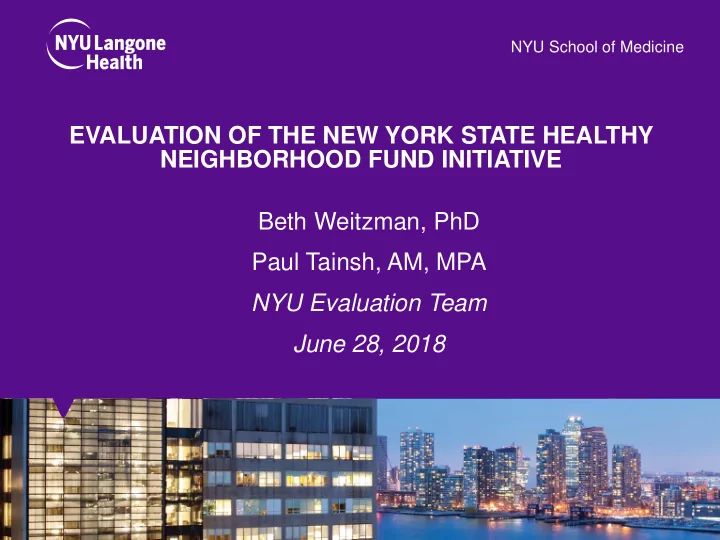

NYU School of Medicine EVALUATION OF THE NEW YORK STATE HEALTHY NEIGHBORHOOD FUND INITIATIVE Beth Weitzman, PhD Paul Tainsh, AM, MPA NYU Evaluation Team June 28, 2018
Components of the Evaluation Assess both the implementation of interventions at individual sites and the overall impact of the Healthy Neighborhoods initiative Process evaluation Environmental changes Behavioral changes 2
Process Evaluation Questions What specific interventions were implemented? What partnerships/collaborations were formed? What barriers and facilitators did sites experience? How sustainable are the interventions? 3
Environmental Change Questions Has the Initiative: Increased the availability of healthy, affordable food ? Resulted in improvements to the built environment ? Linked community residents to programs that support lifestyle changes ? 4
Behavioral Change Questions Has the Initiative changed resident • Purchasing and consumption of healthy foods • Knowledge and motivation toward healthy eating and physical activity • Awareness of community-based resources • Level of community involvement 5
2015-2017 WHAT WE HAVE LEARNED SO FAR
What broad themes have we seen and heard from the field? HNF projects are similar in many ways, but there are important differences in neighborhood and lead organization characteristics Improved healthy food access, parks and public spaces were the starting points, but other areas of neighborhood concern emerged as critical Building and maintaining relationships within and outside the neighborhoods is ongoing work Making good use of available resources is essential 7
What have we learned about project implementation ? Core grantees became network hubs for HNF work. The HNF activities expanded the conversation about health, engaging more organizations and residents in these conversations. The core grantees helped guide outside investments into neighborhood parks, public safety programs and housing developments. External factors affect implementation and collaboration and grantees were able to respond to opportunities as well as challenges. 8
What did we learn about access to healthy and affordable food ? Little change in overall total number of supermarkets or farmers markets from 2015 to 2017 It is challenging to open a new supermarket in underserved neighborhoods and challenging to keep a supermarket open in the face of external factors In most neighborhoods, the challenge for eating healthy is the perceived quality of supermarket foods and getting residents to shop, not the number of supermarkets 9
Food Access Strategies Establishing farmers markets, mobile markets and distributing food boxes Encouraging small food retailers and food pantries to stock and promote healthier food and beverage options Offering cooking demonstrations, nutrition education, farmers market and supermarket tours to influence residents’ choices Assisting farm stands and farmers markets to accept food benefits and distributing food incentive coupons to improve affordability 10
What did we learn about improvements to the built environment ? Local, county and state governments are investing in parks in most of the project neighborhoods. New York City, for example, has committed more than $130 million to park improvements. Grantees had an impact on funding decisions and planned improvements. Public safety concerns are strongly linked to the use of parks and public open spaces. 11
Built Environment Strategies Programming that encouraged people back into parks and open spaces that were under-utilized Neighborhood clean-up and building days improved public spaces and serves as community building activities Way finding and connector projects reconnected residents to local assets such as parks, waterfronts and community spaces Creating safe indoor recreational spaces through programming, especially during cold weather season. 12
What did we learn about linking residents to healthy and active living programs? This program area received relatively less than either food access or improvements to the built environment. Efforts to create web-based referral systems, resource guides and a phone app. Strategies focused on sharing information with residents through social media, newsletters and public presentations Local organizations shared information to improve coordination and reduce duplication of efforts 13
2018-2020 EVALUATION PLAN
Going forward We plan to pay additional attention to: • Efforts to build stronger bonds within the neighborhood • The process of building connections with organizations and resources outside of the neighborhood Look more systematically at: • Community and resident engagement • Organizational development • Collaboration and coalition-building 15
Community and Resident Engagement Examples: Number and types of community and resident engagement activities Number of participants in each type of activity Leadership and other kinds of training, including number of participants and number and type of activities Number of volunteers 16
Organizational Development Examples Integration of health into the mission of the organization Roles of key program staff Intra-agency collaboration on program activities Securing additional grants and investments to support health programming Involvement in broad-based planning efforts 17
Collaboration and Coalition-Building Examples: Connections between grantees and other comprehensive health issues groups or forums Characteristics of partnerships working on shared projects Changes in the number and types of collaborating organizations over time Influence of community health initiatives on broader organizational awareness, programs and policies 18
Upcoming Evaluation Activities Phone check-in calls in July with grantees Continuation of evaluation technical assistance to grantee organizations Site visits to all sites September through November 2018 19
QUESTIONS?
Recommend
More recommend